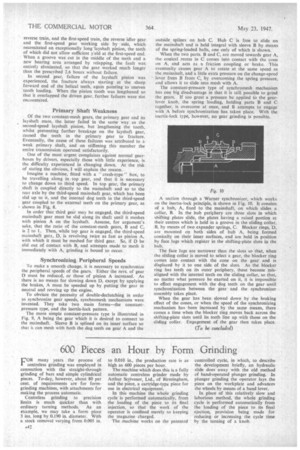600 Pieces an Hour by Form Grinding
Page 52

If you've noticed an error in this article please click here to report it so we can fix it.
FOR many years the process of centreless grinding was employed in connection with the straight-through grinding of bars and simple cylindrical pieces. To-day, however, about 80 per cent. of requirements are for formgrinding machines, with attachments for making the process automatic.
Centreless grinding to precision limits is much quicker than with ordinary turning methods. As an example, we may take a form piece 3 ins, long by 0.190 in. diameter. With a stock removal varying from 0.005 in. to 0.010 in., the production rate is as high as 600 pieces per hour.
The machine which does this is a fully automatic centreless grinder made by Arthur Scrivener, Ltd., of Birmingham, and the piece, a cartridge-type piece for use in electrical equipment.
In this machine the whole grinding cycle is performed automatically, from the loading of the piece to its final injection, so that the work of the operator is confined merely to keeping the magazine charged.
The machine works on the patented controlled cycle, in which, to describe the development briefly, an hydraulic slide does away with the old method of hand-operated plunger grinding. In plunger grinding the operator lays the piece on the workplate and advances the wheels by means of a hand lever.
In place of this relatively slow and laborious method, the whole grinding cycle is performed automatically from the loading of the piece to its final ejection, provision being made for reducing or increasing the cycle time by the turning of a knob.












































































